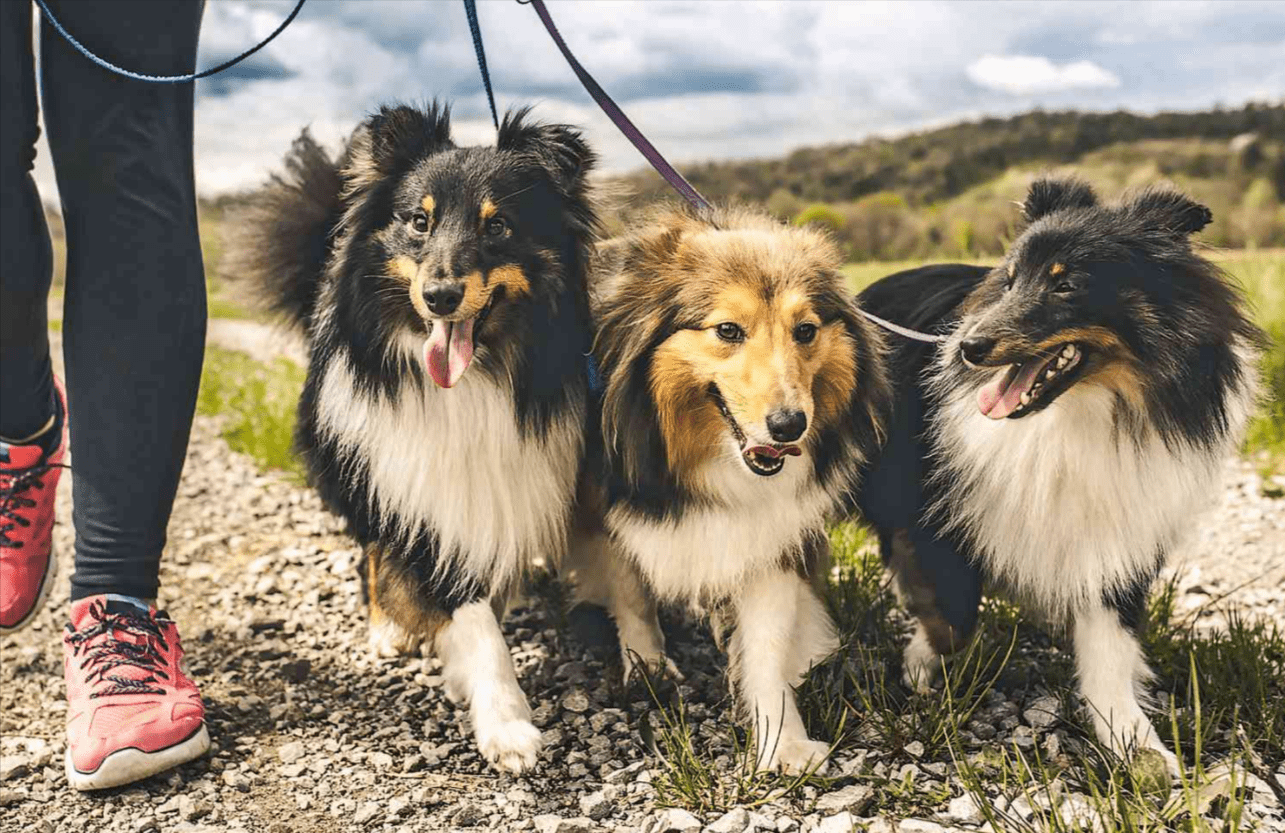The Shetland Sheepdog embodies the essence of Scotland’s rugged Shetland Islands. Often referred to as the “Sheltie,” these dogs are cherished not only for their distinctive looks but also for their rich heritage and loving nature.
The American Kennel Club (AKC) honors the Sheltie for its agility, intelligence, and unique charm.
In this comprehensive guide to Sheltie care, our team will delve into their history and the deep affection that defines their character.
Key Physical Traits of the Shetland Sheepdog
The Shetland Sheepdog is distinguished by its stunning double coat, which combines beauty with practicality. The breed features a dense undercoat and a long, water-resistant outer coat, available in colors like sable, blue merle, and various other shades.
Though they resemble the larger Rough Collie in appearance, Shelties are notably smaller, standing between 13 and 16 inches tall. This smaller size complements their graceful demeanor, and despite their compact stature, they are both robust and energetic.
Exploring the Origins and Heritage of the Shetland Sheepdog
On the harsh and resource-scarce Shetland Islands, the Shetland Sheepdog, or Sheltie, became an essential and adaptable partner for the local islanders. Originally bred to manage sheep, ponies, and poultry, this breed was formerly called the Shetland Collie.
Despite their ancestry involving breeds like the Collie, Pomeranian, and King Charles Spaniel, the Shetland Sheepdog developed into a unique breed. This evolution was driven by the need for a smaller, resilient dog able to endure the harsh climate and rugged terrain of the Shetland Islands.
It wasn’t until the 20th century that these agile herding dogs captured the hearts of dog lovers far beyond their Scottish origins, leaving behind the “collie” label to be recognized as the Shetland Sheepdog.
Every bark echoes their ancestral legacy and the hard work of their forebears. This rich heritage highlights their resilience and adds a significant chapter to the ongoing story of the human-canine connection. What started on a small island has now expanded across continents, becoming an integral part of dog breeding history.
Key Aspects of the Shetland Sheepdog’s Temperament and Behavior
Shelties possess a temperament that shines with warmth, intelligence, and attentiveness, transforming them from mere pets into loyal companions throughout life’s journey. Their herding legacy fuels a keen mind that flourishes with mental challenges and tasks to keep them engaged.
Though small in stature, they possess the heart of a lion and often excel in dog sports and activities that engage their minds. Their sensitivity and gentle nature truly shine at home, where they interact with both children and adults with an intuitive compassion, always attuned to the dynamics of the family.
The Sheltie’s high energy reflects their background as working dogs. To keep their lively spirit focused and positive, they need daily activities such as play, training sessions, or a good run in the yard.
How Much Training and Socialization Do Shetland Sheepdogs Require?
The Shetland Sheepdog is eager to learn new commands and equally devoted to their family. Starting training early, during puppyhood, is crucial for developing a well-mannered and socially skilled adult dog. Establishing a consistent training routine will help them thrive and integrate smoothly into family life.
Positive reinforcement is highly effective with Shelties, as they respond more favorably to praise and encouragement than to reprimands. Early socialization is crucial for this breed, involving exposure to different people, animals, and environments to develop a well-rounded and adaptable personality.
The Sheltie’s instinctive watchdog abilities can be refined with training, helping them distinguish between routine occurrences and genuine threats to avoid unnecessary barking or anxiety. Their loyalty and intelligence contribute to their quick learning in obedience and other skills.
What Are the Health and Care Requirements for Shetland Sheepdogs?
Shetland Sheepdogs are typically hearty dogs with a lifespan of approximately 12 to 14 years, providing many years of companionship and joy. However, like all breeds, they are susceptible to specific health issues and conditions.
Understanding potential health concerns like hypothyroidism, hip dysplasia, von Willebrand disease, and dermatomyositis helps owners work effectively with veterinarians to ensure their Shelties stay healthy. Additionally, Shelties have significant grooming requirements due to their double coat. Regular brushing is essential to maintain their dense undercoat and keep their outer coat looking its best.
Maintaining a Sheltie’s health extends beyond coat care to include proper nutrition. A balanced diet is crucial for supporting their energy, managing weight, and meeting their specific size and metabolic needs. Regular exercise and mental stimulation are equally important, helping to keep them fit and sharp as they grow older. Just as the misty Scottish hills nurture the Sheltie’s spirit, so too does attentive care ensure a happy, healthy life for your furry companion.
Common Health Problems in Shetland Sheepdogs
The Shetland Sheepdog comes with particular considerations that potential owners should be aware of. It is crucial for responsible breeders to uphold the breed’s legacy by ensuring each litter is healthy and adheres to the breed’s distinguished heritage.
Breeders need to be vigilant about certain hereditary diseases, often working with veterinarians to perform genetic tests for conditions such as hypothyroidism and von Willebrand disease. Safeguarding the Shetland Sheepdog breed involves not only breeders but also owners who must stay informed about these health issues.
How to Select and Maintain a Healthy Shetland Sheepdog
Choosing a Shetland Sheepdog involves recognizing their distinct traits and requirements. It’s crucial for potential owners to find Sheltie puppies from trusted breeders who emphasize health, temperament, and strict adherence to breed standards.
Upon welcoming a Sheltie into your home, providing ample space for exercise is essential. A securely fenced yard is ideal to ensure they can stay physically active and healthy.
Caring for a Sheltie involves more than just regular grooming. It requires engaging them with training that challenges their sharp intellect and fulfills their natural drive to work.
Selecting the appropriate dog food is crucial for a Sheltie, considering their size and activity level to avoid overfeeding. Proper care education, along with a commitment to meeting their physical and emotional needs, will help your Sheltie flourish. This dedication ensures that your Sheltie becomes a loyal companion whose life is as fulfilling as the joy they bring to those around them.
Essential Feeding Guidelines for Shelties
Now that you’re familiar with the energetic personality and physical needs of the Sheltie, you may be asking, “What’s the best way to keep my Sheltie healthy and happy with their diet?”
Here’s an in-depth guide to feeding your Sheltie throughout their different life stages.
Sheltie Puppies (under 1 year): A Sheltie puppy is full of energy and needs a high-protein diet to fuel their rapid growth. Choosing a quality puppy food with added nutrients, such as fish oil, can enhance brain development and promote a glossy, healthy coat.
Amount of Food: For a Sheltie puppy, the usual portion is around ¼ to ⅓ cup of food per meal, given three times a day. The precise amount may vary based on your puppy’s weight and activity level.
Adult Shelties (1-7 years): Once your Sheltie reaches adulthood, transition to a diet specifically designed for adult dogs. This type of food balances energy needs and supports healthy weight maintenance. If your Sheltie exhibits signs of food allergies, consider opting for grain-free options.
How Much to Feed: An adult Sheltie typically requires between ½ to ¾ cup of food each day, split into two meals. Adjust the portion according to their level of physical activity and body weight to help prevent obesity.
Tasty Extras: To add variety and nutrition to mealtimes, mix their kibble with fresh foods. Consider adding a sprinkle of probiotics for digestive health and incorporating fatty acids to keep their coat shiny and healthy.
Older Shelties (over 7 years): Senior Shelties require specialized nutrition to accommodate their slower metabolism and help maintain muscle mass. Opt for foods with adjusted calorie content and easily digestible carbohydrates to support their health and well-being as they grow older.
Feeding Amounts: Decrease portion sizes to align with their reduced activity levels. If dental issues arise, opt for softer foods to ensure they can enjoy their meals comfortably and without difficulty.
The Sheltie Legacy: Nurturing a Lifelong Bond and Wellness
Embarking on a journey with a Shetland Sheepdog means stepping into a world filled with companionship, challenge, and exceptional rewards. The Sheltie represents both the rugged beauty of Scotland’s terrain and the warmth of its home life. They are living links to the past and cherished companions for today, reflecting the essence of their island origins.
Owning a Sheltie involves embracing their rich history, understanding their unique characteristics, and committing to their comprehensive care. This relationship demands both responsibility and affection.
As a Sheltie owner, you become a guardian of their distinguished heritage and a devoted friend to a creature whose affection is boundless. Ensure your Sheltie’s well-being with quality nourishment from A Pup Above.



